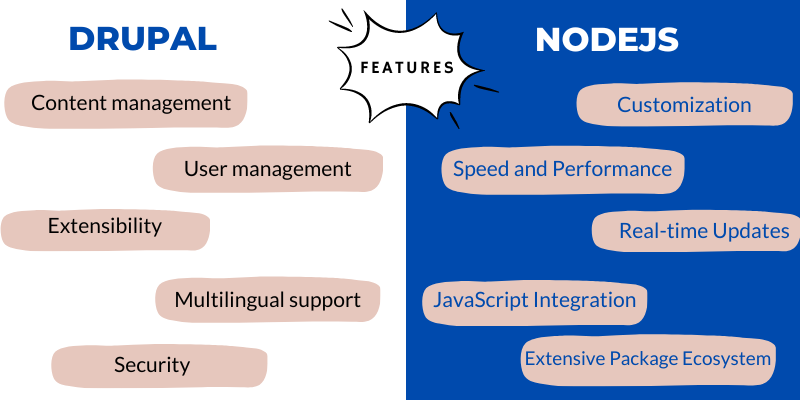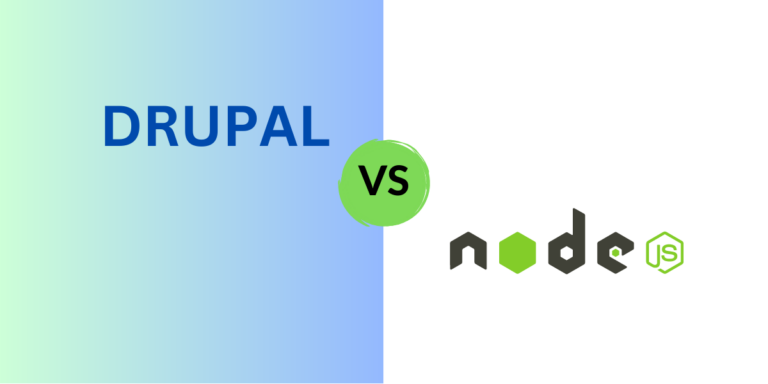As a developer, you are aware that selecting the appropriate content management system (CMS) is crucial for the success of your project. Making a choice might be difficult because there are many options available.
In this article, we will explore two popular web development technologies, Drupal and Node.js, and delve deeper into which one is more suitable for your upcoming web project. Let’s dive in and find out!

What is a CMS?
The content management system or CMS is a software platform used by web developers to create and manage the content or material on their websites. It stores all of your content’s information and makes it available on your website which includes texts, images, music and documents. The CMS is typically built using a scripting language, and its scripts operate on a server that hosts the website and connects to a database. For each page request made to the web server, the scripts combine data from the database and assets such as JavaScript files, CSS files, image files, etc. that are part of the CMS or contents that have been uploaded to create the requested page dynamically. The content and settings for the website are stored in a database.
This article will examine whether Drupal or Nodejs is considered the best CMS. We’ll talk about some of the characteristics that make these platforms unique as well as why they’re so well-liked by developers.
Additionally, Drupal makes it simple to interface with other websites due to its ability to manage complicated forms and workflows. There are more than 16000 modules available, and Drupal can handle both core and add-on modules.
What is Drupal?
Drupal is a free and open-source content management system (CMS) that enables organising, managing, and publishing your content. It is developed using PHP-based environments. This is done under the terms of the GNU, or General Public License, making it free so that anyone can download it and distribute or share it with others. Millions of websites, including WhiteHouse.gov, the World Economic Forum, Stanford University, Examiner.com, and many others, use Drupal.
Why should we use Drupal?
For more than 20 years, Drupal has been used as a content management system (CMS). You can use it for free and modify it to meet your needs because it is open-source software. For its adaptability, scalability, and security, Drupal is popular. It is widely used to build complex websites with in-depth content management capabilities.
Drupal CMS is the most flexible content management system (CMS) for building websites. The power of Drupal allows for the creation of large, complex sites. It is a PHP-based template that enables non-technical users to upload and edit content without any HTML or web design knowledge.
Features of Drupal
Let’s look at some of the important features of Drupal:
- Drupal provides a powerful set of tools for content management.
- Drupal has a robust user management system that allows you to create user accounts, assign roles and permissions, and manage user profiles.
- It also supports single sign-on (SSO) and integration with external authentication providers.
- Since Drupal is an open-source software, there are no licensing costs.
- It has a large repository of modules and themes that can be used to extend its functionality and modify its appearance.
- Drupal offers more than 7000 plug-ins to enhance your website. You can make your own plug-ins for Drupal because it is open-source.
- Drupal is known for its security and has a dedicated security team that is responsible for identifying and patching vulnerabilities.
- Drupal can also run on other technology stacks such as operating systems can be Windows or Mac OS instead of Linux, web servers can be Nginx or IIS instead of Apache and databases can be PostgreSQL or SQLite instead of MySQL.
What is NodeJS?
NodeJS provides a runtime environment for creating scalable server-side JavaScript applications. It includes a non-blocking I/O paradigm and is built on top of Google’s V8 JavaScript engine, which makes it perfect for developing real-time web apps, chat applications, and other applications that need real-time interaction. NodeJS is renowned for its quickness, scalability, and capacity for many concurrent connections.
Developers may create server-side code for web applications using JavaScript thanks to NodeJS, allowing them to use the same language for both the front-end and the back-end of their online apps. As a result, development can go more quickly and effectively because there is no language switching required.
While it is not a content management system (CMS) like WordPress or Drupal, Node.js can be used to build custom CMS solutions or headless CMSs that provide content through APIs that can be consumed by any front-end application or framework.
If you want to read more about Node.js, we have a separate tutorial on What is Node.js? You can also find various topics related to NodeJS on CodeForGeek.
Why Should we use NodeJS?
With the help of NodeJS, programmers can build distinctive CMS solutions that can be tailored to specific needs. Node.js-based CMSs are most suited for modern online applications because of their quick performance, continual upgrades, and robust ecosystem of packages and modules. NodeJS, despite the fact that it may not be a traditional CMS, provides all the tools and functionality required to build a custom CMS solution.
Features Of NodeJS
Let’s look at some important features of NodeJS:
- One of the key advantages of using NodeJS is the ability to tailor a CMS according to specific needs. Node.js developers can create a CMS from scratch or make custom changes to an existing CMS to meet specific requirements. Programmers are able to produce a customised CMS build as a result, one that gives the exact features and capabilities required for the project.
- Due to its excellent performance and scalability, NodeJS is known as the best platform for building large advanced applications. As a result, Node.js-based CMSs can handle heavy traffic loads and complex data structures without slowness or inefficiency.
- Real-time data processing is made possible by Node.js, which is necessary for a contemporary CMS. This implies that there is no need for a page refresh when stuff is changed because it is immediately reflected on the website. This real-time update function enhances user involvement and offers a smooth user experience.
- Operating systems like Windows, MacOS, and Linux are all compatible with Node.js. As a result, development time and expenses can be decreased by using the same codebase to create applications that run on many platforms.
- Integrating a CMS with leading JavaScript frameworks like React, Vue.js, and Angular is easy because Node.js is based on JavaScript. As a result, CMS-driven apps can be developed and deployed quickly.
- Additionally, Node.js can also be used to create a headless CMS that delivers content via APIs that can be used by any front-end framework or application. This architecture gives developers more flexibility and allows them to create web applications on any platform or technology.
Conclusion
In conclusion, Node.js and Drupal are both powerful technologies that have their own strengths and weaknesses. The best choice for your next web project depends on your specific project requirements and goals. After going through this article, you will surely understand the features of both technologies and what sets them apart and choose the one according to your project requirements.
Also Read:
- NodeJS vs Spring: Which is Best for Your Next Enterprise Web Application? | CodeForGeek
- NodeJS vs Ruby On Rails: Essential Guide to Choosing the Best Backend Technology in 2023 | CodeForGeek
For more information on Drupal, you can refer to their official documentation or click here





